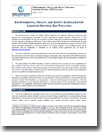24 pages | © April 2017 World Bank Group | Complimentary
 The Environmental, Health, and Safety (EHS) Guidelines are technical reference documents with general and industry-specific examples of Good International Industry Practice (GIIP). When one or more members of the World Bank Group are involved in a project, these EHS Guidelines are applied as required by their respective policies and standards. These industry sector EHS Guidelines are designed to be used together with the General EHS Guidelines document, which provides guidance to users on common EHS issues potentially applicable to all industry sectors.
The Environmental, Health, and Safety (EHS) Guidelines are technical reference documents with general and industry-specific examples of Good International Industry Practice (GIIP). When one or more members of the World Bank Group are involved in a project, these EHS Guidelines are applied as required by their respective policies and standards. These industry sector EHS Guidelines are designed to be used together with the General EHS Guidelines document, which provides guidance to users on common EHS issues potentially applicable to all industry sectors.
The EHS Guidelines for Liquefied Natural Gas (LNG) Facilities include information relevant to LNG base load liquefaction plants, transport (by sea and land), storage, regasification (including floating storage regasification units), peak shaving terminals, and LNG fueling facilities. For coastal LNG facilities – including harbors, jetties, and in general coastal facilities (e.g., coastal terminals, marine supply bases, loading/offloading terminals), additional guidance is provided in the EHS Guidelines for Ports, Harbors, and Terminals. For EHS issues related to vessels and floating storage units, additional guidance is provided in the EHS Guidelines for Shipping. EHS issues associated with road transportation of LNG are addressed in the General EHS Guidelines. Issues related to liquefied petroleum gas/condensate production and storage in liquefaction plants are not covered in this Guideline.
Download full publication [PDF]
Supplemental information:
- Environmental, Health, and Safety Guidelines (including General and Industry Sector EHS Guidelines)
- Technical Revision of the World Bank Group Environmental, Health, and Safety Guidelines
- IFC's Sustainability Framework - 2012 Edition
- Environmental, Health, and Safety Guidelines / Pollution Prevention and Abatement Handbook - Provided as reference material only; replaced by the 2007 versions.